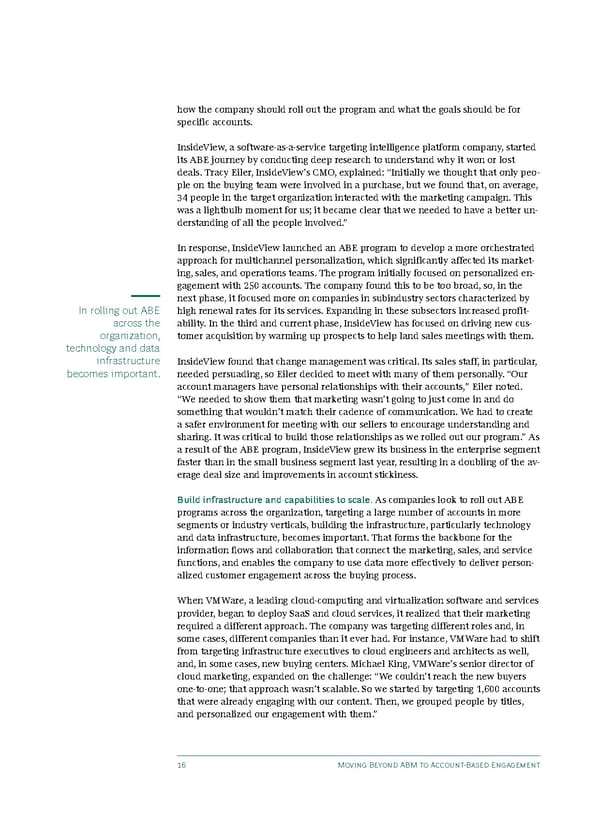how the company should roll out the program and what the goals should be for specific accounts. InsideView, a software-as-a-service targeting intelligence platform company, started its ABE journey by conducting deep research to understand why it won or lost deals. Tracy Eiler, InsideView’s CMO, explained: “Initially we thought that only peo- ple on the buying team were involved in a purchase, but we found that, on average, 34 people in the target organization interacted with the marketing campaign. This was a lightbulb moment for us; it became clear that we needed to have a better un- derstanding of all the people involved.” In response, InsideView launched an ABE program to develop a more orchestrated approach for multichannel personalization, which significantly affected its market- ing, sales, and operations teams. The program initially focused on personalized en- gagement with 250 accounts. The company found this to be too broad, so, in the next phase, it focused more on companies in subindustry sectors characterized by In rolling out ABE high renewal rates for its services. Expanding in these subsectors increased profit- across the ability. In the third and current phase, InsideView has focused on driving new cus- organization, tomer acquisition by warming up prospects to help land sales meetings with them. technology and data infrastructure InsideView found that change management was critical. Its sales staff, in particular, becomes important. needed persuading, so Eiler decided to meet with many of them personally. “Our account managers have personal relationships with their accounts,” Eiler noted. “We needed to show them that marketing wasn’t going to just come in and do something that wouldn’t match their cadence of communication. We had to create a safer environment for meeting with our sellers to encourage understanding and sharing. It was critical to build those relationships as we rolled out our program.” As a result of the ABE program, InsideView grew its business in the enterprise segment faster than in the small business segment last year, resulting in a doubling of the av- erage deal size and improvements in account stickiness. Build infrastructure and capabilities to scale. As companies look to roll out ABE programs across the organization, targeting a large number of accounts in more segments or industry verticals, building the infrastructure, particularly technology and data infrastructure, becomes important. That forms the backbone for the information flows and collaboration that connect the marketing, sales, and service functions, and enables the company to use data more effectively to deliver person- alized customer engagement across the buying process. When VMWare, a leading cloud-computing and virtualization software and services provider, began to deploy SaaS and cloud services, it realized that their marketing required a different approach. The company was targeting different roles and, in some cases, different companies than it ever had. For instance, VMWare had to shift from targeting infrastructure executives to cloud engineers and architects as well, and, in some cases, new buying centers. Michael King, VMWare’s senior director of cloud marketing, expanded on the challenge: “We couldn’t reach the new buyers one-to-one; that approach wasn’t scalable. So we started by targeting 1,600 accounts that were already engaging with our content. Then, we grouped people by titles, and personalized our engagement with them.” 16 Moving Beyond ABM to Account-Based Engagement
 BCG moving beyond ABM to account based engagement Page 17 Page 19
BCG moving beyond ABM to account based engagement Page 17 Page 19